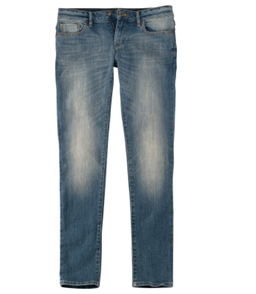Now You Know Bleach Wash of Woven Denims: Analysis of before and after Wash Properties (Part-2)
Friday, 8 March 2019
Edit
Bleach Wash of Woven Denims: Analysis of before and after Wash Properties (Part-2)
S.M. Bappy Rana
Dept. of Textile Engineering
Bangladesh University of Business & Technology
Cell: +8801781630519
Dept. of Textile Engineering
Bangladesh University of Business & Technology
Cell: +8801781630519
2.5 Denim Washing:
In today's trend Denim has achieved much preference to teenagers as well as baby to adult as blue jeans. According to the fashionable denim garments, subjected to versatile washing techniques to obtain a worn, vintage look with various effects like as hand sand, whiskers, 3D, Nicking, Destroy etc. To produce a fading effect is the main object of denim washing without affecting the main body fabrics and patchiness, crinkles, seam puckering, hairiness, de-pilling, softened-hand feel, stabilized dimensions etc.
 |
| Figure: Denim pant |
- Wet process
- Dry process
Dry process:
- Hand Scrapping
- Whiskering
- P.P. Spray
- P.P.Sponging
- PermanentWrinkle
- Tagging
- Destroy
- Grinding
In the process a strong oxidative bleaching agent like sodium hypochlorite or KMnO4 is added during the washing with or without stone addition. Discoloration produced is usually more apparent depending on strength on the bleach liquor quality, temperature and treatment time. It is preferable to have strong bleach with short treatment time.
Care should be taken for the bleached goods so that they should be adequately antichlored or after washed with peroxide to minimize yellowing. Materials should be carefully stored before processing for color uniformity.
ENZYME WASH:
It is environmentally friendly wash. It involves the application of organic enzymes that eat away at the fabric, i.e. the cellulose. When the desired color is achieved, the enzyme can be stopped by changing the alkalinity of the bath or its temperature. Post treatment includes final ringing and softening cycle. The effects produced by cellulose enzyme are:—
- Use of cellulose making the seams, hems, and pockets more noticeable;
- Salt paper effect is color contrast effect.
- Faded garment washed with acid cellulose enzyme provides less color contrast in proportion to garment washed neutral cellulose enzymes.
ACID WASH:
It is done by tumbling the garments with pumice stones presoaked in a solution of sodium hypochlorite or potassium permanganate for localized bleaching resulting in a non uniform sharp blue/white contrast. In this wash the color contrast of the denim fabric can be enhanced by optical brightening. The advantage of this process is that it saves water as addition of water is not required.
It consists of soaking pumice stones with chlorine and using their abrasive power to bleach jeans into sharp contrasts. Also known as moon, fog, marble, ice and frosted.
STONE WASH:
In the process of stone washing, freshly dyed jeans are loaded into large washing machines and tumbled with pumice stone or volcanic rock to achieve a soft hand and desirable look. Variations in compositions, hardness, size shape and porosity make these stone multifunctional. The process is quite expensive and requires high capital investment. Pumice stone give the additional effect of a faded or worn look as it abrades the surface of the jeans like sandpaper, removing some dye particles from the surfaces of the yarn.
Microsanding:
A fabric finishing process where fabrics are sanded (real sandpaper) to make the surface soft without hair. Can be performed before or after dyeing. In this fabric treatment process, a series of cylindrical rolls in a horizontal arrangement, either wrapped with an abrasive paper or chemically coated with an abrasive are used to create a soft, sueded hand. The denim is pulled over the face of the sand rollers creating a raised surface finishing. Some color reduction is experienced.
There are 3 ways for this technique:
- Sandblasting.
- Machine sanding.
- Hand sanding or hand brushing.
2.7.1 History of bleach:
The earliest form of bleaching involved spreading fabrics and cloth out in a bleach field to be whitened by the action of the sun and water. Modern bleaches resulted from the work of 18th century scientists including Swedish chemist Carl Wilhelm Scheele, who discovered chlorine, French scientists Claude Berthollet, who recognized that chlorine could be used to bleach fabrics and who first made sodium hypochlorite (Eau de Javel, or Javel water, named after a quarter in Paris where it was produced) and Antoine Germain Labarraque, who discovered the disinfecting ability of hypochlorite’s. Scottish chemist and industrialist Charles Tennant first produced a solution of calcium hypochlorite, then solid calcium hypochlorite (bleaching powder).
Louis Jacques Thénard first produced hydrogen peroxide in 1818 by reacting barium peroxide with nitric acid. Hydrogen peroxide was first used for bleaching in 1882, but did not become commercially important until after 1930. Sodium perborate as a laundry bleach had been used in Europe since the early twentieth century, but did not become popular in North America until the 1980s.
2.7.2 What is Bleach?
Bleach is a chemical that removes colors or whitens, often via oxidation. Common chemical bleaches include household chlorine bleach, a solution of approximately 3–6% sodium hypochlorite (NaClO), and oxygen bleach, which contains hydrogen peroxide or a peroxide-releasing compound such as sodium perborate, sodium percarbonate, sodium persulfate, tetrasodium pyrophosphate, or urea peroxide together with catalysts and activators, e.g. tetraacetylethylenediamine and/or sodium nonanoyloxybenzenesulfonate. To bleach something is to apply bleach, sometimes as a preliminary step in the process of dyeing. Bleaching powder is calcium hypochlorite.
Many bleaches have strong bactericidal properties, and are used for disinfecting and sterilizing. Most bleaches are hazardous if ingested or inhaled, and should be used with care.